Canada Plum
Prunus nigra
Rose family (Rosaceae)
Prunus nigra
Rose family (Rosaceae)
Description:
This is usually a small tree with a short trunk and a crown with an
ovoid or broadly ovoid outline; it is typically 10–25' tall at
maturity. On older trees, the trunk bark is gray and rough-textured,
while on younger trees it is reddish brown and smooth with white
lenticels. Both primary and especially secondary branches are abundant;
primary branches are usually ascending while secondary branches are
divergent. The bark on branches and twigs is reddish brown and smooth
with white lenticels. Young shoots are light green to red, terete, and
briefly hairy. There are usually thorny spur-twigs along the branches
and, to a lesser extent, the trunk of this small tree. These thorn-like
twigs are up to 4" long and relatively straight. Alternate leaves occur
along the twigs and young shoots of this small tree. The leaves are
2½–4½" long and 1–2½" across; they are obovate in shape, although they
taper somewhat abruptly into long slender tips. The leaf bases are
broadly wedge-shaped, rounded, or slightly cordate. The leaf margins
are doubly serrate-crenate; their teeth are blunt-tipped, rather than
acute. Minute glands or glandular scars often occur on the teeth of the
leaves (10x hand lens may be required to see).
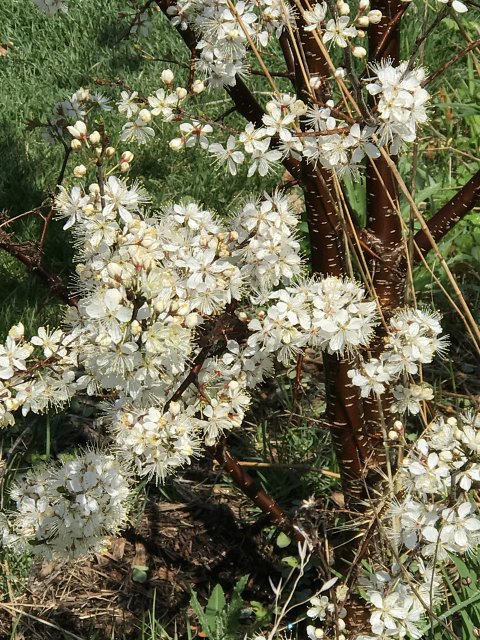
The surface of young emerging leaves is often reddish, the surface of more mature leaves is yellowish green or medium green. The upper surface of mature leaves is glabrous and it is indented along the network of primary and secondary veins. The lower surface of mature leaves is sometimes hairy along the central and primary veins. The petioles are ¼–1" long and light green to reddish green; individual petioles usually have 1 or 2 tiny protuberant glands near the leaf bases that can be seen with the naked eye. Small umbels of 2-4 flowers develop from the axils of last year's leaves; they usually appear before the vernal leaves of the current year develop. Individual flowers are about 1–1¼" across, consisting of 5 widely spreading white petals, a calyx with 5 lobes, about 30 stamens with long white filaments and pale yellow anthers, and a pistil. The petals are obovate in shape and they taper to a narrow base; as they age, they may become light pink.
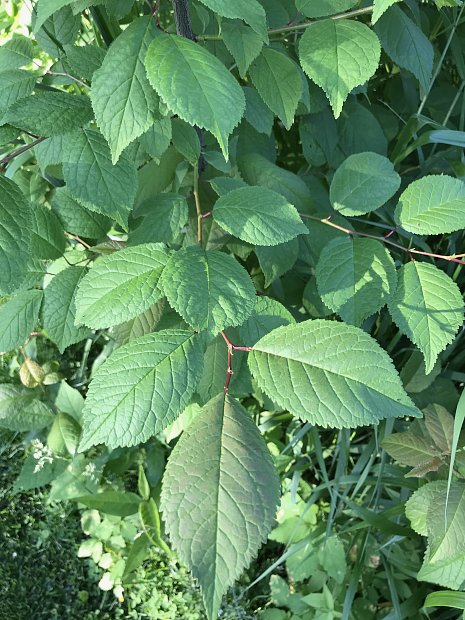
The calyx and its lobes have a dark red exterior and a light green to dark red interior; it is usually glabrous, although the exterior of the calyx sometimes has sparse hairs. The lobes of the calyx are 3-5 mm. long and bluntly lanceolate in shape. The margins of the calyx lobes have tiny glandular teeth that are visible to the naked eye. The floppy pedicels of the flowers are ½–1½" long, reddish green to dark red, and glabrous (rarely sparsely hairy). The blooming period occurs from mid- to late spring, lasting about 1-2 weeks. The flowers have a pleasantly sweet fragrance. Afterwards, fertile flowers are replaced by fruits (drupes) that become about 1–1¼" across and globoid to broadly ovoid in shape at maturity. At this time (typically late summer or early autumn), the exterior of such fruits are red, orange, or yellow, glabrous, and sometimes slightly glaucous. These edible fruits have a fleshy yellow interior (tart to slightly sweet or tart) and a large stone (hardened seed) in the middle. This stone is broadly ellipsoid and somewhat flattened in shape; there is a narrow ridge on one side and a shallow narrow groove on the other. The root system is woody and branching; sometimes this root system suckers, producing clonal offsets that can develop into small trees.
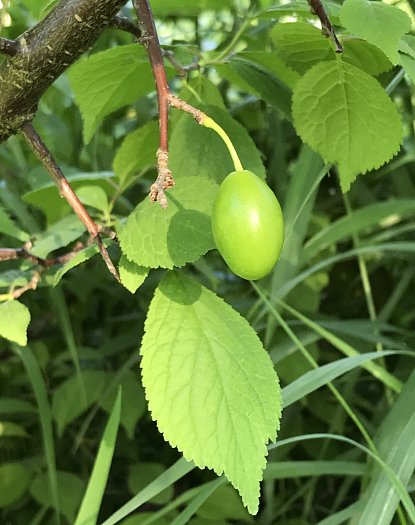
Cultivation: The preference is full or partial sun, moist to mesic conditions, cool to warm summer weather, and soil containing loam or sandy loam. This small tree produces attractive fragrant flowers during the spring and attractive fruits during late summer to early autumn. Wild forms of this tree are somewhat thorny, but there are thornless cultivars of it, including those with dark purple leaves and pink flowers.
Range & Habitat: The native Canada Plum (Prunus nigra) is occasional in NE Illinois and west-central Illinois, while in other areas of the state it is uncommon or absent (see Distribution Map). This small tree is found primarily in the upper Midwest, the New England area, and adjacent parts of Canada. Illinois lies at its southwestern range-limit. Habitats include open woodlands, woodland borders, thickets, meadows in wooded areas, areas near bodies of water, and abandoned fields. These habitats include both sandy and non-sandy areas. Canada Plum is usually found in higher quality natural areas.
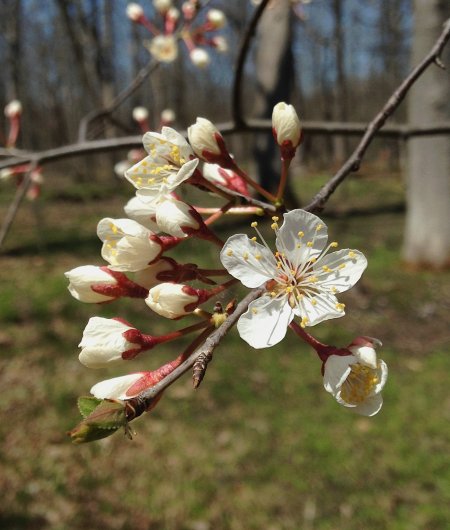
Faunal Associations: Wild plums (Prunus spp.) are visited primarily by bees, including honeybees, bumblebees, cuckoo bees (Nomada spp.), Halictid bees, and Andrenid bees. Other insects that occasionally visit the flowers for nectar and/or pollen include Syrphid flies, bee flies, other flies, butterflies, and beetles. Some insects feed destructively on the leaves, plant sap, fruits, and other parts of these small trees. Insects that have been reported from Canada Plum (Prunus nigra) include Hyalopterus pruni (Mealy Plum Aphid), Hysteroneura setariae (Rusty Plum Aphid), Myzus persicae (Green Peach Aphid), Chionaspis furfura (Scurfy Bark Scale), and larvae of Euzophera semifuneralis (American Plum Borer Moth); see Robinson & Bailey (1965), Blackman & Eastop (2013), the ScaleNet website (accessed 2014), and Cranshaw (2004). Other insects that feed destructively on Plum trees include miscellaneous beetles, true bugs, leafhoppers (Macropsis spp.), treehoppers, mealy bugs, larvae of sawflies, larvae of many moths, and caterpillars of such butterflies as Callophrys henrici (Henry's Elfin), Limenitis archippus (Viceroy), and Satyrium titus (Coral Hairstreak); see Clark et al. (2004), DeLong (1948), Dennis (1952), Covell (1984/2005), Bouseman & Sternburg (2001), and other sources.

The American Black Bear has been observed to feed on the fruits of Canada Plum (Noyce & Coy, 1990). Other vertebrate wildlife that feed on wild plums include Elk (leaves & twigs), Ruffed Grouse (fruits), Deer Mouse (plum pits), Franklin Ground Squirrel (plum pits), and Eastern Box Turtle (fallen fruits); see Andersen & Fleharty (1967), Bennetts (1900), Houtcooper (1978), and Shimp & Shimp (1982). The Hoary Bat sometimes uses larger plum trees for daytime roost sites (Schneider et al., 2006).
Photographic Location: An overgrown meadow in Lake County, Illinois. The photos were taken by Paul Showers (Copyright © 2018).
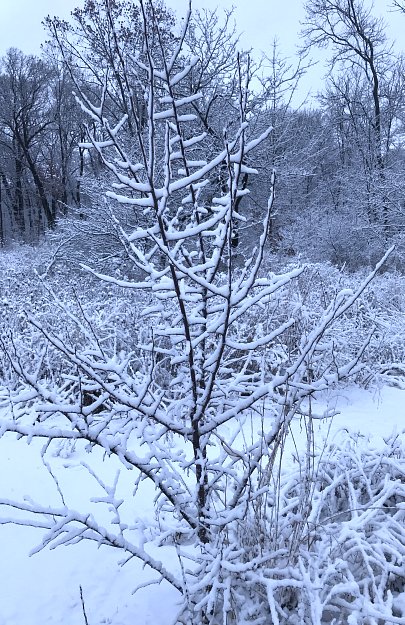
Comments: Canada Plum has many attractive characteristics, including showy flowers, large colorful fruits, and smooth reddish brown bark. There are several native plum species and a few non-native plum species in Illinois – distinguishing these different species can be difficult. However, Canada Plum has several distinctive characteristics: 1) its flowers are at least ¾" across (usually they are larger) and sometimes become light pink as they age, 2) its flowers have a pleasant sweet fragrance, rather than an unpleasant odor, 3) the calyces of its flowers are dark red, rather than light green or pale yellow, 4) the lobes of its calyces are minutely toothed and glandular, rather than toothless and glandless, 5) its fruits are larger in size than average (at least ¾" across, but they are usually larger in size), 6) its fruits tend to have a more elongated shape (for example, broadly ovoid) than the fruits of other plums, 7) its leaves have blunt teeth, rather than acute teeth, 8) its leaves taper rather abruptly into long slender tips, rather than tapering gradually, 9) its leaves tend to be wider in shape and more rounded at the base than other plums, 10) there are typically 1-2 protuberant tiny glands on the petioles of its leaves, and 11) there are tiny glands or tiny glandular scars on the teeth of its leaves, although this may be difficult to see. In contrast, a common native plum species, American Plum (Prunus americana), which is distributed throughout Illinois, has slightly smaller flowers (typically ¾" across) with an unpleasant odor, the calyces of its flowers are typically light green or yellowish green rather than dark red, the lobes of its calyces are toothless and usually glandless, its leaves have more acute teeth along their margins, and the petioles of its leaves are usually glandless.

The surface of young emerging leaves is often reddish, the surface of more mature leaves is yellowish green or medium green. The upper surface of mature leaves is glabrous and it is indented along the network of primary and secondary veins. The lower surface of mature leaves is sometimes hairy along the central and primary veins. The petioles are ¼–1" long and light green to reddish green; individual petioles usually have 1 or 2 tiny protuberant glands near the leaf bases that can be seen with the naked eye. Small umbels of 2-4 flowers develop from the axils of last year's leaves; they usually appear before the vernal leaves of the current year develop. Individual flowers are about 1–1¼" across, consisting of 5 widely spreading white petals, a calyx with 5 lobes, about 30 stamens with long white filaments and pale yellow anthers, and a pistil. The petals are obovate in shape and they taper to a narrow base; as they age, they may become light pink.

The calyx and its lobes have a dark red exterior and a light green to dark red interior; it is usually glabrous, although the exterior of the calyx sometimes has sparse hairs. The lobes of the calyx are 3-5 mm. long and bluntly lanceolate in shape. The margins of the calyx lobes have tiny glandular teeth that are visible to the naked eye. The floppy pedicels of the flowers are ½–1½" long, reddish green to dark red, and glabrous (rarely sparsely hairy). The blooming period occurs from mid- to late spring, lasting about 1-2 weeks. The flowers have a pleasantly sweet fragrance. Afterwards, fertile flowers are replaced by fruits (drupes) that become about 1–1¼" across and globoid to broadly ovoid in shape at maturity. At this time (typically late summer or early autumn), the exterior of such fruits are red, orange, or yellow, glabrous, and sometimes slightly glaucous. These edible fruits have a fleshy yellow interior (tart to slightly sweet or tart) and a large stone (hardened seed) in the middle. This stone is broadly ellipsoid and somewhat flattened in shape; there is a narrow ridge on one side and a shallow narrow groove on the other. The root system is woody and branching; sometimes this root system suckers, producing clonal offsets that can develop into small trees.

Cultivation: The preference is full or partial sun, moist to mesic conditions, cool to warm summer weather, and soil containing loam or sandy loam. This small tree produces attractive fragrant flowers during the spring and attractive fruits during late summer to early autumn. Wild forms of this tree are somewhat thorny, but there are thornless cultivars of it, including those with dark purple leaves and pink flowers.
Range & Habitat: The native Canada Plum (Prunus nigra) is occasional in NE Illinois and west-central Illinois, while in other areas of the state it is uncommon or absent (see Distribution Map). This small tree is found primarily in the upper Midwest, the New England area, and adjacent parts of Canada. Illinois lies at its southwestern range-limit. Habitats include open woodlands, woodland borders, thickets, meadows in wooded areas, areas near bodies of water, and abandoned fields. These habitats include both sandy and non-sandy areas. Canada Plum is usually found in higher quality natural areas.

Faunal Associations: Wild plums (Prunus spp.) are visited primarily by bees, including honeybees, bumblebees, cuckoo bees (Nomada spp.), Halictid bees, and Andrenid bees. Other insects that occasionally visit the flowers for nectar and/or pollen include Syrphid flies, bee flies, other flies, butterflies, and beetles. Some insects feed destructively on the leaves, plant sap, fruits, and other parts of these small trees. Insects that have been reported from Canada Plum (Prunus nigra) include Hyalopterus pruni (Mealy Plum Aphid), Hysteroneura setariae (Rusty Plum Aphid), Myzus persicae (Green Peach Aphid), Chionaspis furfura (Scurfy Bark Scale), and larvae of Euzophera semifuneralis (American Plum Borer Moth); see Robinson & Bailey (1965), Blackman & Eastop (2013), the ScaleNet website (accessed 2014), and Cranshaw (2004). Other insects that feed destructively on Plum trees include miscellaneous beetles, true bugs, leafhoppers (Macropsis spp.), treehoppers, mealy bugs, larvae of sawflies, larvae of many moths, and caterpillars of such butterflies as Callophrys henrici (Henry's Elfin), Limenitis archippus (Viceroy), and Satyrium titus (Coral Hairstreak); see Clark et al. (2004), DeLong (1948), Dennis (1952), Covell (1984/2005), Bouseman & Sternburg (2001), and other sources.

The American Black Bear has been observed to feed on the fruits of Canada Plum (Noyce & Coy, 1990). Other vertebrate wildlife that feed on wild plums include Elk (leaves & twigs), Ruffed Grouse (fruits), Deer Mouse (plum pits), Franklin Ground Squirrel (plum pits), and Eastern Box Turtle (fallen fruits); see Andersen & Fleharty (1967), Bennetts (1900), Houtcooper (1978), and Shimp & Shimp (1982). The Hoary Bat sometimes uses larger plum trees for daytime roost sites (Schneider et al., 2006).
Photographic Location: An overgrown meadow in Lake County, Illinois. The photos were taken by Paul Showers (Copyright © 2018).

Comments: Canada Plum has many attractive characteristics, including showy flowers, large colorful fruits, and smooth reddish brown bark. There are several native plum species and a few non-native plum species in Illinois – distinguishing these different species can be difficult. However, Canada Plum has several distinctive characteristics: 1) its flowers are at least ¾" across (usually they are larger) and sometimes become light pink as they age, 2) its flowers have a pleasant sweet fragrance, rather than an unpleasant odor, 3) the calyces of its flowers are dark red, rather than light green or pale yellow, 4) the lobes of its calyces are minutely toothed and glandular, rather than toothless and glandless, 5) its fruits are larger in size than average (at least ¾" across, but they are usually larger in size), 6) its fruits tend to have a more elongated shape (for example, broadly ovoid) than the fruits of other plums, 7) its leaves have blunt teeth, rather than acute teeth, 8) its leaves taper rather abruptly into long slender tips, rather than tapering gradually, 9) its leaves tend to be wider in shape and more rounded at the base than other plums, 10) there are typically 1-2 protuberant tiny glands on the petioles of its leaves, and 11) there are tiny glands or tiny glandular scars on the teeth of its leaves, although this may be difficult to see. In contrast, a common native plum species, American Plum (Prunus americana), which is distributed throughout Illinois, has slightly smaller flowers (typically ¾" across) with an unpleasant odor, the calyces of its flowers are typically light green or yellowish green rather than dark red, the lobes of its calyces are toothless and usually glandless, its leaves have more acute teeth along their margins, and the petioles of its leaves are usually glandless.